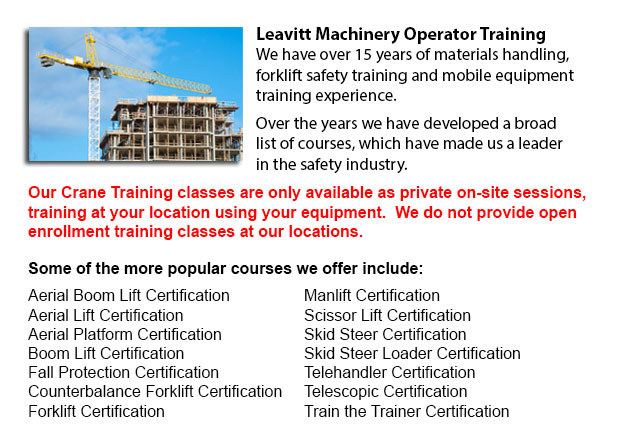
Nanaimo Crane Certification - The Crane Certification Program covers the industry recommended content which would teach the efficient and safe operation of cranes. The person will train in the following: pre-operational, operational and post operating requirements; how to identify cranes and their component parts; how to determine overall lift capacity; rigging components and inspection/rejection criteria; and requirements specific to the work location where the individuals training would be working.
The requirements which should be done before operating a crane like for instance assigning authority for the pre-operational check; doing the sequential pre-operational check based on the manufacturer's specifications or specifications certified by a professional engineer; checking the log book for comments; checking the work place for hazards and obstacles; inspecting hooks, chains, cables, safety latches and crane movement; making certain of the correct functioning of operational controls; and learning how to ensure the crane's disconnect switch/isolator is functioning right.
Operational requirements include identifying roles and responsibilities, and determining the need for a formal lift plan. Trainees would know how to perform a danger assessment connected to environmental conditions, physical circumstances and employees. Subject matter includes determining when to seek competent help, the destination of loads and the safest route, and load weight and centre of gravity.
It is vital for individuals training to be able to identify an over-capacity lift, select right rigging equipment, know load limits, and determine a safe position from which to operate. Trainees would review both site-specific and universal crane signals for lifts, and techniques for traveling, lifting and loading. Appropriate maintenance practice will be included.
The individuals training will undergo an examination to test their knowledge of emergency response techniques for different circumstances, specially electrical or mechanical failures. They will be asked to describe shut down and parking procedures for security and safety, to follow tagging and lock out procedures, and to explain the reason why near misses are recorded and reported to the right person. Log book records should be maintained.
The person training would be taught the particulars of rigging, and learn the responsibility and authority for rigging. They would be taught to identify the various types of rigging, storage procedures and the load capacity ratings.
Post-operational requirements comprise entering defects or deficiencies, maintenance and service history within the log book, based on Federal, state and provincial codes requirements.
Also, we include site-specific needs to be able to meet the employers requirements into our crane certification training program.
-
Nanaimo Boom Lift Certification
Nanaimo Boom Lift Certification - Using elevated work platforms allow for maintenance operations and work to be carried out at elevated work heights which were otherwise not reachable. Workers making use of scissor lifts and boom lifts can learn how... More -
Nanaimo Boom Lift Safety Training
Nanaimo Boom Lift Safey Training - Boom lifts are a kind of aerial lifting device or elevated work platform which are commonly used in industry, warehousing and construction. Boom lifts could be utilized in practically whichever environment because o... More -
Nanaimo Loader Operator Training
Nanaimo Loader Operator Training - Loader Operator Training - Forklift training is a prerequisite within North America and is intended to prevent workplace death and injuries. Lift truck training provides driver training intended for forklift operato... More -
Fall Protection Certification in Nanaimo
There are high numbers of injuries at work associated to falling and lots of fall-related deaths reported each and every year. Most of these instances might have been prevented with better training, better measures in place, and by properly equipping... More -
Nanaimo Crane Ticket
Nanaimo Crane Ticket - The modern version of a crane can be either complex or simple, and cranes vary based on their use. Mobile cranes, for example are rather simple. A telescopic boom or steel truss mounts its movable platform. A system of levers o... More -
Operator Safety Certification | Re-Qualification Certification | In-House Instructor Certification in Nanaimo
Lift trucks are used in practically all industrial construction sites and in warehouse operations and in boat yards. The reach feature of a forklift is a very important part utilized in several applications like when a shelving system is being used t... More -
Aerial Lift / Boom Lift / Man Lift / Scissor Lift Certification in Nanaimo
Scissor hoists are lift tables which lift up materials and individuals and supplies vertically. They are normally used in construction, commercial and industrial environments. A common use of scissor hoists is for lowering or lifting construction sup... More -
Crane / Overhead Crane / Self-Erect Crane / Truck Mounted Crane / Hydraulic Cranes Certification in Nanaimo
Bridge cranes or likewise called overhead cranes are a type of industrial material handling crane utilizing a line and hook apparatus that runs on a horizontal beam running along two widely separated rails. Several overhead cranes can be seen inside... More

Forklift Certification Nanaimo
TOLL FREE: 1-888-254-6157
Nanaimo, British Columbia
forkliftcertificationnanaimo.com
Email Us
About Us


